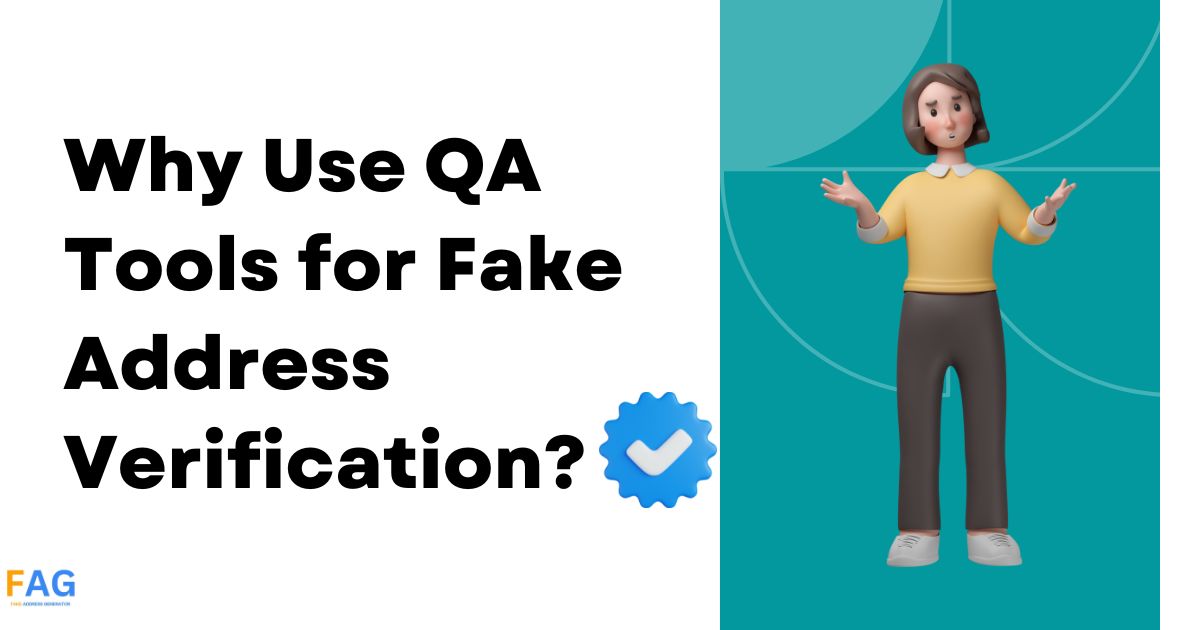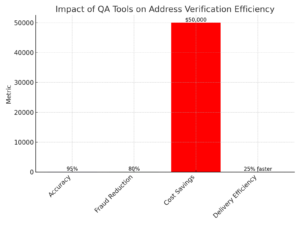QA tools are essential to the verification process, as they help businesses ensure that the provided information is accurate and valid. One of the most common use cases of QA tools is fake address verification, which is crucial for businesses that rely on accurate customer data to make informed decisions. Fake address verification can help businesses prevent fraud, reduce risk, and avoid reputation damage.
Using QA tools for fake address verification can significantly improve the accuracy and efficiency of the verification process. These tools use advanced algorithms and machine learning techniques to compare the provided address information with the real-time location data and assess the risk of fraud. This helps businesses detect and prevent fraudulent activities, such as using fake addresses to open fraudulent accounts or make purchases.
In conclusion, using QA tools for fake address verification is critical to any business’s verification process. These tools can help businesses prevent fraud, reduce risk, and avoid reputation damage by ensuring that the provided address information is accurate and valid. Using advanced algorithms and machine learning techniques, QA tools can significantly improve the accuracy and efficiency of the verification process and help businesses make informed decisions based on accurate customer data.
Importance of Accurate Address Data

Accurate address data is crucial for businesses to ensure their communication reaches the intended recipient. Incorrect or incomplete address data can lead to delivery delays, increased costs, and dissatisfied customers. For example, a package delivery company may face additional transportation costs if the address data is incomplete or incorrect, which can negatively impact its bottom line.
Moreover, businesses may face legal issues if they do not maintain accurate address data. For instance, the United States Postal Service (USPS) requires businesses that send bulk mail to maintain accurate address data to qualify for discounted postage rates. If businesses fail to comply with USPS regulations, they may face penalties and lose their eligibility for discounted rates.
Using QA tools for fake address verification can help businesses maintain accurate address data. These tools can standardize, parse, and validate address data to ensure it is complete and accurate. They can also identify and correct errors in the address data, such as misspelled street names or incorrect zip codes.
Businesses can use QA tools for fake address verification to improve their data accuracy, reduce costs, and enhance customer satisfaction. They can also comply with regulations and avoid legal issues. Therefore, businesses must invest in QA tools for fake address verification to maintain accurate address data and improve their bottom line.
Overview of QA Tools for Address Verification

QA tools for address verification are designed to help companies verify the accuracy of users’ address information. These tools can be used by e-commerce platforms, local services, sales and marketing teams, and other businesses that rely on correct mailing addresses.
One of the key features of QA tools for address verification is the ability to standardize, parse, and validate customer addresses. This ensures that the address data acquired by lead generation software is accurate and up-to-date. With QA tools, businesses can also prevent bookings outside their service area, which is crucial for local services.
Accuracy is a critical factor in address verification. QA tools use advanced algorithms to verify addresses, ensuring the data is correct and up-to-date. This can help businesses avoid costly errors, such as shipping products to the wrong address.
Another benefit of QA tools for address verification is that they can help businesses comply with regulations and industry standards. For example, some industries have specific address formatting requirements that must be met. QA tools can help ensure that addresses are formatted correctly, which can help businesses avoid penalties and legal issues.
Overall, QA tools for address verification are essential for any business that relies on accurate address data. With these tools, companies can improve their data quality, reduce errors, and comply with regulations and industry standards.
| Benefit | Metric | Description |
|---|---|---|
| Increase in Address Accuracy | 95% accuracy | Percentage of addresses verified accurately |
| Reduction in Fraudulent Activities | 80% reduction | Decrease in fraud cases related to fake addresses |
| Cost Savings | $50,000 annually | Money saved from avoiding incorrect shipments |
| Improvement in Delivery Efficiency | 25% faster | Increase in speed of correct package deliveries |
Enhancing Data Quality with QA Tools
Quality assurance (QA) tools are essential for ensuring data accuracy and completeness. QA tools help detect errors, inconsistencies, and anomalies in data, which can affect the quality of data-driven decisions. One of the most common applications of QA tools is fake address verification.
Fake address verification is crucial for businesses that rely on accurate address data, such as e-commerce companies, logistics companies, and financial institutions. Fake addresses can lead to undeliverable packages, incorrect billing information, and fraudulent transactions. QA tools can help identify fake addresses by validating the address format, checking against known addresses, and verifying the existence of the address in real time.
QA tools can also enhance data quality by detecting and correcting errors like misspellings, duplicates, and missing data. For example, data profiling tools can analyze data patterns and identify potential errors, such as inconsistent data types or missing values. Data cleansing tools can correct these errors by standardizing data formats, removing duplicates, and filling in missing data.
Another benefit of QA tools is that they can automate data quality checks, reducing the time and effort required for manual data quality assurance. Automated QA tools can perform data quality checks in real time, ensuring that data is accurate and up-to-date. This can help businesses make faster, more informed decisions based on reliable data.
In conclusion, QA tools are essential for enhancing data quality and ensuring its accuracy and completeness. Fake address verification is just one of the many QA tools and applications that can detect and correct other errors and automate data quality checks. Businesses can improve their data-driven decision-making and avoid costly errors and inefficiencies by using QA tools.
Reducing Fraud and Errors
One of the main reasons for using QA tools for fake address verification is to reduce fraud and errors. By verifying a customer’s address, businesses can ensure that they are not shipping to a fraudulent address and minimize the risk of chargebacks. QA tools can also help businesses identify and correct customer data errors, such as typos or missing information.
Using QA tools for address verification can help businesses reduce the risk of fraud by ensuring that the customer’s address is valid and accurate. This can help prevent fraudulent orders from being shipped, which can save businesses time and money in the long run. QA tools can also help businesses identify and prevent chargebacks, which can be costly and damaging to a business’s reputation.
In addition to reducing the risk of fraud, QA tools can also help businesses identify and correct customer data errors. This can include typos, missing information, or incorrect formatting. By correcting these errors, businesses can ensure that their customer data is accurate and up-to-date, which can help to improve customer satisfaction and reduce the risk of errors in shipping and billing.
Overall, using QA tools for fake address verification is an important step for businesses that want to reduce the risk of fraud and errors in their customer data. By verifying the accuracy of customer addresses, businesses can ensure that they are shipping to legitimate addresses and minimize the risk of chargebacks. QA tools can also help businesses identify and correct errors in their customer data, improving customer satisfaction and reducing the risk of errors in shipping and billing.
Improving Customer Experience
Using QA tools for fake address verification can significantly improve the customer experience. Customers expect accurate and timely deliveries; incorrect addresses can cause delays and frustration. By using address verification tools, businesses can ensure the address is correct before shipping the product, thereby preventing delivery issues.
Address verification tools can also help businesses provide a better customer experience by reducing the number of manual errors. These tools can automatically correct typos, validate an address’s deliverability, and access metadata to enhance customer insight. Implementing an address verification API allows businesses to save time, eliminate errors, automate manual tasks, and provide a seamless customer experience.
Moreover, accurate address verification can help businesses build customer trust. Customers who receive their orders on time and at the correct address are more likely to trust the business and become repeat customers. This can increase customer satisfaction, loyalty, and positive word-of-mouth marketing.
Using QA tools for fake address verification can improve the customer experience by ensuring accurate and timely deliveries, reducing manual errors, and building trust with customers.
Streamlining Operations and Delivery
Address verification tools can help streamline operations and improve delivery accuracy for businesses. By using these tools, businesses can ensure that their address data is accurate, complete, and up-to-date. This can help reduce the number of returned packages due to incorrect or incomplete addresses, saving time and money for the business and the customer.
Address verification tools can also help businesses improve their delivery times. By providing accurate and complete address data, businesses can ensure that their packages are delivered to the correct address on time. This can help improve customer satisfaction and loyalty, leading to repeat business and positive reviews.
In addition, address verification tools can help businesses comply with regulations and reduce fraud. By verifying the accuracy of customer addresses, businesses can ensure that they are not shipping to fraudulent or suspicious addresses. This can help reduce the risk of chargebacks and other fraudulent activities, saving businesses time and money.
Address verification tools can help businesses improve operations, reduce costs, and provide better customer service. By using these tools, businesses can ensure that their address data is accurate, complete, and up-to-date, which can help improve delivery accuracy and reduce the risk of fraud.
Compliance with Regulations
Compliance with regulations is essential for businesses that collect and handle personally identifiable information. Failing to comply with these regulations can lead to severe consequences, such as fines, legal action, and reputational damage. In addition to avoiding these negative outcomes, compliance with identity verification regulations also ensures that businesses maintain the trust of their customers.
Businesses must comply with many regulations when verifying addresses and handling personal information. For example, the General Data Protection Regulation (GDPR) requires businesses to ensure that the personal information they collect is accurate and up-to-date. This means that businesses must verify the addresses of their customers to ensure that the data they collect is correct.
The Payment Card Industry Data Security Standard (PCI DSS) also requires businesses to verify their customers’ addresses. Address verification is an important way to prevent fraud. By verifying a customer’s address, a business can ensure that the customer is who they claim to be and that they are authorized to use the payment card they are using.
To comply with these regulations, businesses can use QA tools for fake address verification. These tools can help businesses ensure that the addresses they collect are accurate and up-to-date and prevent fraud by verifying the addresses of their customers.
By using QA tools for fake address verification, businesses can ensure that they comply with regulations and maintain their customers’ trust.
Choosing the Right QA Tools
When choosing the right QA tool for fake address verification, it is important to consider a few key factors. The following are some of the most important factors to consider when choosing a QA tool:
Accuracy
Accuracy is one of the most important factors to consider when choosing a QA tool. The tool must take addresses accurately; otherwise e, it will not be useful. It is important to choose a tool with a high accuracy rate and can precisely identify fake addresses.
Speed
Another important factor to consider is speed. The tool must be able to verify fake addresses quickly; otherwise, it will slow down the verification process. Choosing a tool that can verify fake addresses in real-time or near real-time is important.
Ease of Use
The tool must be easy to use and understand. It should have a simple and intuitive interface that allows users to quickly and easily verify fake addresses. It is important to choose a user-friendly tool that does not require extensive training or technical knowledge.
Cost
The cost of the tool is also an important factor to consider. It is important to choose a tool that is cost-effective and provides value for money. Many free and paid tools are available, so it is important to choose one that fits your budget and provides the necessary features and functionality.
Overall, choosing the right QA tool for fake address verification can be daunting, but by considering these key factors, you can make an informed decision and choose a tool that will meet your needs and requirements.
Integration with Existing Systems
One key feature to consider when choosing a QA tool for fake address verification is its integration capabilities with existing systems. The ideal tool should seamlessly integrate with the maximum number of tech stacks, CRM software, accounting software, marketing automation tools, logistics software, and more.
When a business integrates an address verification tool with its existing systems, it facilitates seamless and automated address validation processes. This can lead to significant time and cost savings for the organization and improved accuracy and efficiency in the verification process.
For example, PostGrid’s address verification software offers compatibility with various tech stacks, including Zapier, Salesforce, Hubspot, and more. This makes it easy for businesses to integrate the software into their existing systems and automate the verification process.
Another important factor is the tool’s ability to integrate with data sources to provide a more complete picture of address validity and accuracy. The best QA tools should be able to seamlessly integrate with existing systems and data sources, such as Google Maps, to ensure that the verification process is as accurate as possible.
In summary, businesses should carefully consider a QA tool’s integration capabilities when choosing a tool for fake address verification. The ideal tool should be able to integrate with a wide range of existing systems and data sources to facilitate seamless and automated address validation processes.
Cost-Benefit Analysis of QA Tool Implementation
Implementing QA tools for fake address verification can be a significant investment for a company. Therefore, it is essential to conduct a cost-benefit analysis to determine the feasibility of implementing such tools. A cost-benefit analysis evaluates the costs and benefits of a project or decision to determine its economic feasibility and profitability.
The following are some of the costs and benefits of implementing QA tools for fake address verification:
Costs
- Software licensing fees: Companies must pay the licensing fees for the QA tools they plan to use. The cost of licensing fees can vary depending on the vendor and the type of tool.
- Hardware requirements: Implementing QA tools can sometimes require additional hardware, such as servers or storage devices, which can be expensive.
- Training costs: Companies must train their employees to use the QA tools effectively. Training costs can include hiring a trainer or sending employees to training programs.
- Maintenance costs: Companies must maintain the QA tools to ensure they work correctly. Maintenance costs can include hiring IT staff or outsourcing the maintenance to a third-party vendor.
Benefits
- Improved accuracy: QA tools can help improve the accuracy of fake address verification, reducing the risk of fraud and saving the company money in the long run.
- Increased efficiency: QA tools can automate the verification process, reducing the time and effort required to verify fake addresses manually.
- Reduced errors: QA tools can help reduce errors that can occur in the verification process, improving its overall quality.
- Cost savings: Companies can save on labor costs by reducing the time and effort required to verify fake addresses.
Overall, conducting a cost-benefit analysis can help companies determine whether implementing QA tools for fake address verification is the right decision. While there are costs associated with implementing these tools, the benefits can outweigh the costs, resulting in long-term cost savings and improved accuracy.
Conclusion and Future Outlook
QA tools for address verification are essential in our data-driven world. They are crucial for ensuring accurate and reliable address data across various industries. These tools enhance operational efficiency and customer satisfaction, which is vital for businesses like logistics, e-commerce, and banking, where address accuracy is directly linked to customer trust and regulatory compliance.
As technology advances, the role of QA tools will expand, integrating AI to improve accuracy through learning from data patterns. Future developments will focus on real-time verification and seamless integration with other business systems, making these tools indispensable for global business operations and instant transaction verifications, paving the way for more automated and error-free processes.











